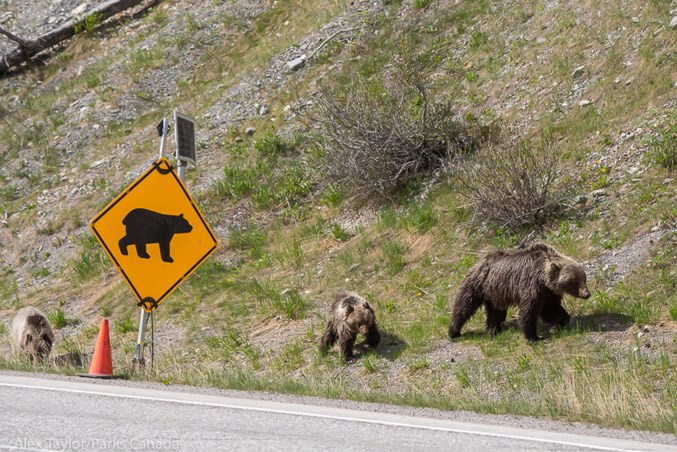KOOTENAY NP – An infamous female grizzly bear feeding alongside Highway 93 South in Kootenay National Park is being pushed into the forest away from the road in a bid to keep her safe.
Bear No. 167 – a grizzly that was fed French fries two years ago and was filmed walking along a highway barrier earlier this spring – is one of at least nine bears that prompted Parks Canada to implement a no-stopping zone along a 15-kilometre stretch of highway.
Fitted with a GPS collar earlier this month to track her movements, the five-year-old bruin is the focus of an aversive conditioning campaign, in which rubber bullets, beanbag rounds and noisemakers are used repeatedly to try to teach her that the roadside is a bad place to be.
“We are worried about the potential for more negative situations with her in the future, so we started aversive conditioning on her,” said Jon Stuart-Smith, a wildlife management specialist.
“We have staff during daylight hours on scene to try and haze her from the roadside into cover. Any time she comes out of cover we’re going to haze her, trying to give her the message that if she steps out, that’s not where we want her to be.”
The negative experience for bears associated with aversive conditioning can prevent habituation and reduce the chance that bears will learn to seek out food sources near roads, where plants like dandelions flourish in spring.
Repeated exposure to vehicles and people can cause bears to become habituated and lose their natural wariness of people. Bears that frequent roadsides are also at a greater risk of being struck and killed by passing vehicles.
The no-stopping zone, which is between McKay Creek Operations Centre above Radium Hot Pools and Settler’s Road, intends to give bears the chance to feed undisturbed and as well as prevent traffic congestion that is dangerous for both bears and people.
At least eight other bears are feeding throughout that area, including No. 167’s mother with two cubs in their second year, a female black bear with two cubs of last year and at least two other individual black bears.
“They are all in that stretch focusing on the seasonal availability of food,” said Stuart-Smith.
“The no-stopping zone will remain in place until bears move away from the highway as food becomes more plentiful at higher elevations.”
Parks Canada wardens and the RCMP are regularly patrolling that stretch of highway. Anyone caught violating the no-stopping zone could face a $115 on-the-spot ticket or a mandatory court appearance and a maximum fine of $25,000.
Stuart-Smith said people should also be reminded that feeding wildlife is strictly forbidden, which has been an issue along Highway 93 South in the past few years.
“There have been charges in the past,” he said, noting a 2017 charge against an Edmonton man who was slapped with a $2,500 in court for feeding French fries to grizzly bear No. 167.
“Feeding wildlife is the worst thing that can happen in this zone. We’re trying to make sure people aren’t stopping and running the risk of bears being fed.”
If you see people feeding wildlife, please report the incident to Banff dispatch at 403-762-1470.




